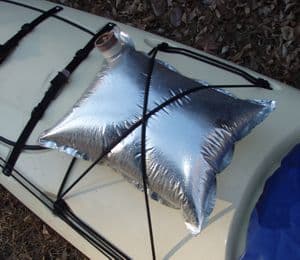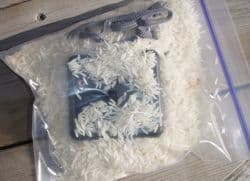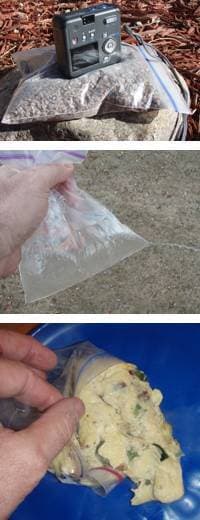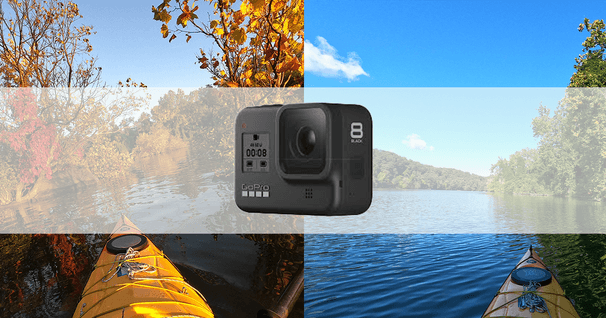It's In The Bag
The Versatile Wine Box Liner Bag
Remember the old wine boxes that came with the silver foil-coated bladder? Did you know that this bladder has many uses for kayaking? It can easily take the place of a pillow, a pad, flotation (although not an official device) and possibly a signaling device! Pretty versatile beyond its primary use as a high-volume, collapsible wine jug!

Because of its sturdy build and very leak-proof spout, the wine liner bag makes a great container for other consumable liquids as well. It's a fantastic water jug because once its emptied for the last time it can be deflated and stored in a very small area. Even partially filled with liquid it can double serve as a pillow or pad.
I have never pushed the nozzle to its bursting point by applying pressure to the cap. I can say that I have applied a tremendous amount of pressure to the filled or inflated bag to no negative outcome. The tight-fitting nozzle comes off repeatedly without compromising its tight and leak-proof fit.
Renowned Hawaiian paddler, Audrey Sutherland used several inflated wine bags in her inflatable kayak on many trips along the NaPali coast in the Hawaiian Islands. Her craft had wine bags stuffed throughout her interior that served as seat pad, back cushion and who knows what!
I've used the bags as a camp pillow - it's like a "Select Air" pillow in that you can adjust its firmness with a flick of a flap on the spout. Because it does fold down into a palm-sized, stow-a-way item, you can pack it away during moves from camp to camp.
Apparently newer wine box liners are not covered with the shiny, silver coatings. However, they should work as well as liquid containers or pads. The most important consideration with any container that's had another food/beverage is to clean it out thoroughly.
Another advantage lost on the newer, clear bags is the radar reflectability of the silver-sided bags. I am not convinced that these are very effective being so close to the water and hence below many radar ranges. However, some say they do work, especially if positioned higher up out of the water. For a while proponents would attach these silver bags to those antenna-like extensions bicyclists use.
The bag, either inflated or flattened, could be used as a sun reflector - a big "mirror" solar signaling device. It easily compacts down to fit into a pocket on a PFD or sprayskirt. The bag offers about 1.25 square feet of reflective surface when cut open (defeating several other uses, of course!).
Next time you decide to do that group picnic thing, consider a box of wine. It may not appeal to the chic tastes of some of your friends, but will get you closer to the liner's second life without wasting its first.
Bag of Rice to the Rescue
I offer this one as a plausible option. Since many of us carry some form of compact, electrical equipment into the field - or onto the water - in the form of cell phones, non-waterproof cameras and other small devices, it makes sense to have some way to rescue these items should they get wet. Maybe "damp" or "moisture-threatened" is a better word since a complete dunking in the drink pretty much does a fatal number on these devices.

Advice posted on a web page a while back suggested to someone who's cell phone had gotten wet to place the entire unit into a small bag filled with uncooked rice! See where this is going? The rice absorbs the moisture from the unit - inside and out. It doesn't really damage the rice and it certainly can help rid the unit of minute molecules of water.
I presume that while the rice would technically work equally well on a cell phone, camera or other similar equipment, the integrity and detail within each piece would determine whether it would dry out enough to function again.
Another important advantages of the bag of rice is: Boiling water? - Just add chicken and veggies…
Photographer's Friend
I always carry a few sealable plastic bags in my outdoor photography backpack. These are great for two reasons: It's always nice to have a spare bag or container handy and since the plastic bags take up next to no room, bring some along - dual purpose their availability by putting film or filters or anything in them.

They are most useful when filled with a few handfuls of course sand or very small gravel. The right amount of flexible fill turns them into a bean bag base upon which a camera can be set. This ensures sharper images obtained usually with the help of a tripod. You can set the bag on an uneven surface to level it off. I've used this method, the bag filled with sand, to get several group shots of kayaking buddies on a beach. Just fill and empty the bag as needed throughout your trip.
Other Uses
The uses of the plastic freezer storage bags are practically endless. They offer a good, waterproof storage pocket for anything that will fit inside. Larger bags work well as map cases or document holders. Field first aid responders can use the bags to deliver a stream of water to help clean out a wound (fill with water, snip off a tiny portion of one corner to create a controllable stream flow to flush debris out of cuts and such). I even used one once to temporarily patch a hole in the bottom of my shoe!
They also work wonders in the camp kitchen as packets of favorite spice and herb mixes or pre-measured dry ingredients. They can even be used to cook a scrambled egg mix for breakfast (add eggs, veggies and pre-cooked bacon or sausage to a freezer bag and drop into boiling water - several minutes later you have a baggie of freshly-cooked scrambled eggs!).
Always carry a few bags in your gear -- a use for them can come up when you least expect it.
Tom Watson, an avid sea kayaker and freelance writer is also the author of "How to Think Like A Survivor" available on Amazon.com and most major bookstores.
Related Articles
~A Paddler's Post submitted by Gregg Jackson~ For decades I had combined the joys of hiking and…
A discussion on the use of a compass from a kayaking standpoint begins with basic compass savvy and then…
Ever tried to really get a steady view through binoculars while on the water? Even on a calm surface,…
A kayaking buddy, we'll call him "Ben", is one heck of a paddler. He's got years of big, blue water…



